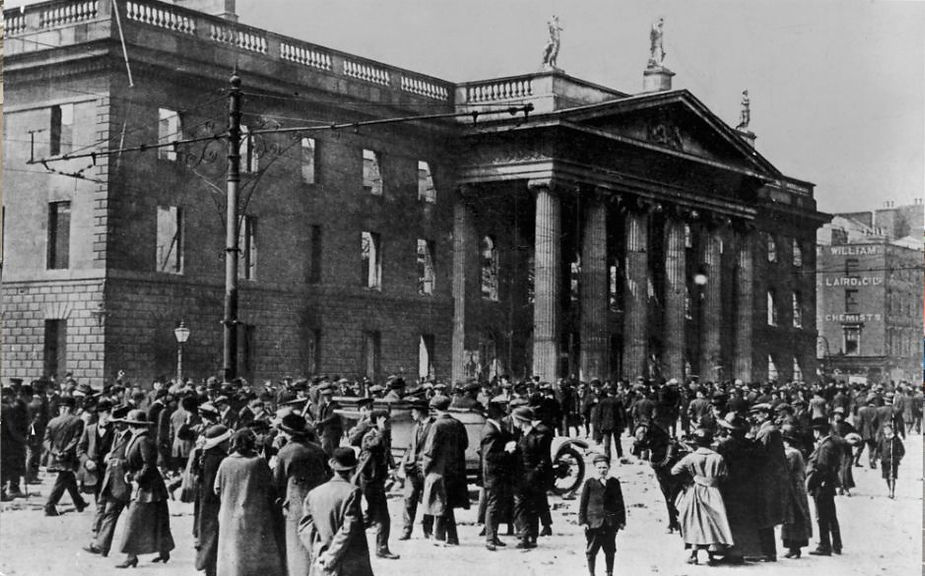
This week we’re going to take a break from the doom and gloom of various plagues that have rocked the nation, and instead look at a very different kind of national event. Easter is of course a religious holiday for many across the globe, but in Ireland it often holds very different connotations and stirs memories of an outbreak of a very different sort. The 1916 Easter Rising holds a special place in the hearts of many Irish people today, and represents a major moment in the struggle for independence that eventually became a reality. Of the brave men and women who took part and gave their lives, it is often easy for us to remember only a few, but some 2,500 ‘rebels’ took part, from all over the country. Today we will look at some of our own.

The GPO, the centre for most of the action in 1916. Source: The Irish Times
Most of you reading will not need a recap, but for our readers overseas who may be wondering, the 1916 Easter Rising took place primarily in Dublin from April 24th to the 29th in (you guessed it) 1916. The uprising was launched by a group of rebels and idealists against the British forces in Ireland, who had decided that political methods were not the answer to the Irish problem and only armed insurrection would achieve their ends. The leaders included Padraig Pearse (a schoolteacher and poet who became the face of the rising), James Connolly (a socialist well-known in Dublin labour circles), Éamon de Valera (who would go on to become one of the best known faces in twentieth century Irish politics) and Constance Markewicz (a prominent figure in Irish society and the only woman leader). Together they took over several important sites and buildings around Dublin to best curtail the movements of the British army and the RIC (Royal Irish Constabulary), such as the General Post Office (GPO), Boland’s Mills, Jacob’s Biscuit Factory and St. Stephen’s Green. The fighting continued for five days after Padraig Pearse read a Proclamation of Independence from the steps of the GPO on O’Connell Street. The first shots were actually fired in County Laois rather than in Dublin, though the first victim of the rising was Constable James O’Brien, an unarmed RIC officer on duty in Dublin Castle.
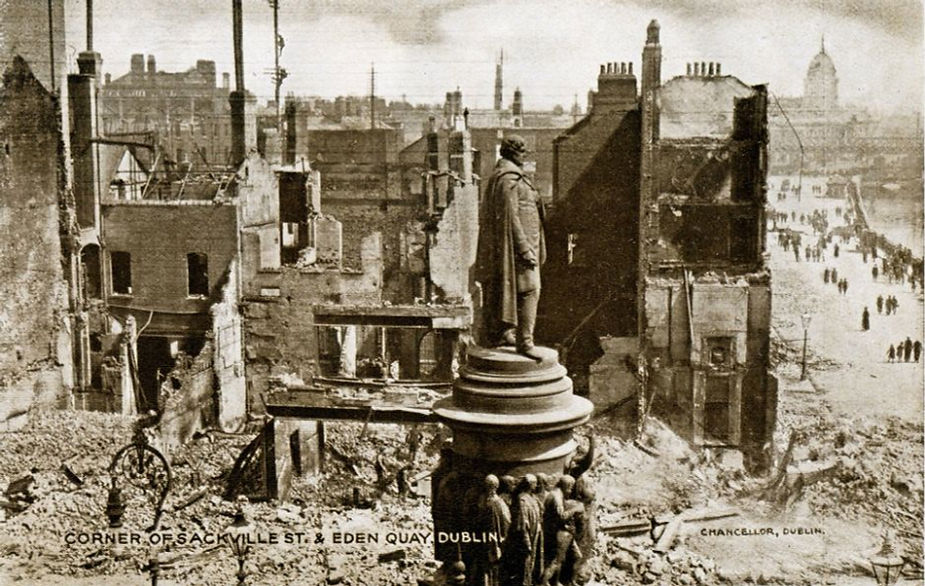
Dublin in ruins. Source: The Irish Times
Technically speaking, the rising was a failure; 485 people lost their lives, 2,600 were wounded, property damage was immense and in the aftermath the country was placed under martial law. However, the rising had an unintended side effect: people all over Ireland, regardless of their feelings on the matter previously, were stirred to action by the courage of the leaders, and their subsequent execution was met with widespread outrage. The following year an illegal Irish parliament would be declared as people rallied behind the cause and in 1919 a guerilla war resulted in a treaty that would kick-start the independence of Ireland once and for all.

The aftermath of the 1916 Easter Rising. Source: The Irish Times
While the figure is sometimes disputed, four Waterford men certainly took part in the rising events in Dublin. Of course the best known among them was Richard Mulcahy, who later became a prominent politician. In 1916, Mulcahy was employed in the engineering department of the Royal Mail, working in Thurles, Bantry, Wexford and Dublin. Mulcahy was well-known in patriotic circles, being a member of the Gaelic League, the Irish Volunteers and the Irish Republican Brotherhood. In the volunteers, he was a member of the Fingal Battalion where he was second in command to Thomas Ashe. This battalion was involved in a major battle (and victory) at Ashbourne Co. Meath, where despite a shortage of men, a lack of ammunition and weaponry and relative inexperience (Ashe was only made a commander shortly before the rising) they engaged the RIC in a five and a half hour battle. The battle at Ashbourne resulted in the death of eleven RIC men and two volunteers, but 24 hours after the end of the rising, the Fingal Battalion honoured the orders of Patrick Pearse and surrendered to the RIC.

Richard Mulcahy. Source: Waterford County Musuem
Mulcahy was arrested and imprisoned first in Knutsford and then in Frongoch. He was released in December of 1916 and once again joined the volunteers, becoming a commandant of the Dublin Brigade, was elected to the first Dáil in 1917 and was IRA Chief of Staff from 1919 to 1922 during the War of Independence and the Irish Civil War. Mulcahy would go on to hold several important positions in Government, from Minister of Education to Minister of Defence and leader of Fine Gael. He would also go on to marry Min Ryan, a relative of our very own Keeper of the Bishop’s Palace – Rosemary Ryan!
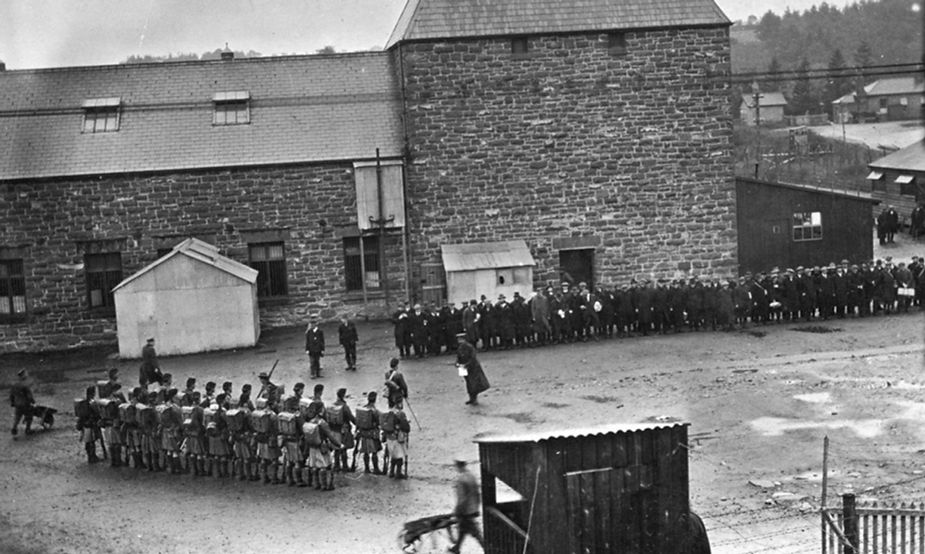
Frongoch Internment camp would be used to house many of the prisoners from the rising, including Michael Collins
Two Waterford men were members of the Maynooth Company and found themselves present in the GPO on that fateful week in April 1916: John Graves and Liam O’Regan. Graves was a shop assistant who had joined the volunteers three years earlier and was responsible for filling cartridges and making pikes to be sent to Volunteers in Mayo, O’Regan worked in the same grocery store and hardware shop though his role is a little less clear. Both men were from the Gaeltacht region of An Rinn in County Waterford and despite being very young at the time, made up part of the fifteen-man company that travelled to Dublin on Easter Monday. The fighting had actually started the previous day, but owing to the confusion around the events, the Maynooth company didn’t arrive for over 24 hours. They walked the 25km route to the GPO, bringing guns, ammunition, pikes and sandwiches to tide themselves over!
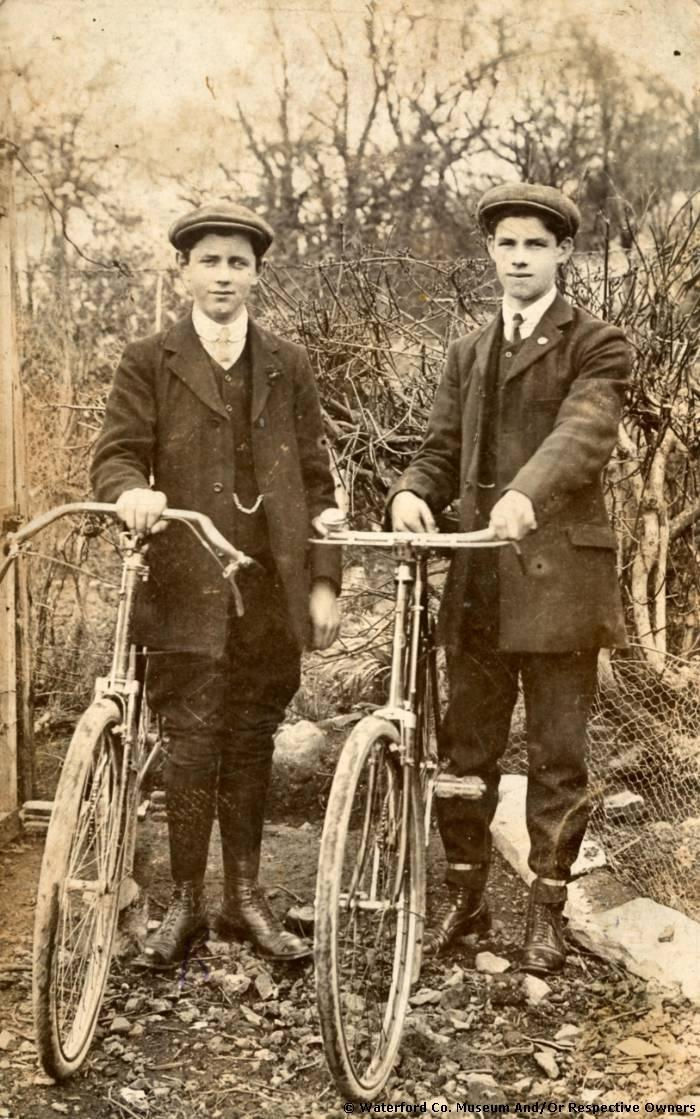
Graves and O’Regan in Maynooth c 1915. Source: Waterford County Museum
On their arrival in Dublin they were greeted warmly by James Connolly at the door of the GPO, and while they were initially deployed to the Royal Exchange Hotel, they later returned to the GPO – the epicentre of the rising itself. Over the next few days they were heavily involved, with O’Regan stating that his role involved ‘dangerous dispatch work, guarding windows, reconnoitring enemy positions’ and other important duties – O’Regan was responsible for moving the wounded to safety, apparently even evacuating Connolly after he was shot. The two were arrested following the surrender, O’Regan immediately and Graves a little later, back in Maynooth. Both men were released from their prisons in Autumn of 1916 and upon release they re-joined the Irish volunteers. They each survived into their seventies and while their role in the Rising was not officially recognised for some time, the Decade of Commemorations committee erected a statue in their honour in their home of An Rinn back in 2016.
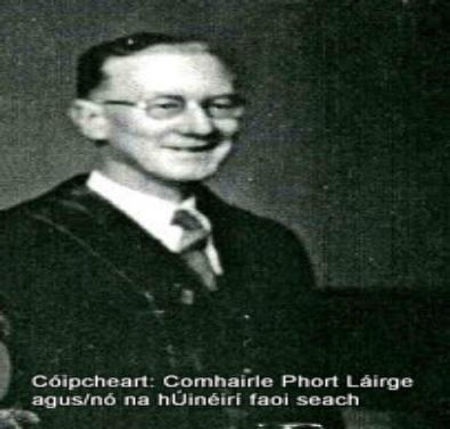
Liam Raftis. Source: Waterford County Museum
Of these men, perhaps the luckiest in the immediate aftermath was Liam Raftis – Raftis was never actually arrested, managing to escape amid the confusion brought about by the end of the rising. He had been stationed at Boland’s Mills where they were responsible for controlling the railway and the road leading from Dun Laoghaire in order to control British backup troops being sent to the city centre. Raftis was ordered to surrender along with the rest of the force at Boland’s Mills, but he instead sought an escape route! He did however receive a suspension from his job at the Great Southern and Western Railway when he was unable to provide an alibi and explain his whereabouts during the rising. It wasn’t all bad news for Raftis though, he went on to become City Manager in Waterford during the 1950s, a role he kept into his seventies! Years after the rising when Raftis met his former commander, Éamon de Valera once again, de Valera is reported to have remarked ‘ Last time I saw you was climbing over the wall of Westland Row Railway Station’.
These four stories are in many ways, remarkably similar, and while only Mulcahy may have gone on to play a role in the new republic, each of them played an important role in the making of it. The 1916 Easter Rising may have been a military failure, but for these four men and the other 2,500 that fought alongside them it represented the match that lit the flame of independence.
Further Reading:
Waterford’s 1916 Combatants: http://www.waterfordcouncil.ie/departments/culture-heritage/archives/exhibitions/waterford1916-1918/waterford-1916-combatants.htm
Catherine Foley, ‘An Irishwoman’s Diary: 1916 fighters from Ring’: https://www.irishtimes.com/opinion/an-irishwoman-s-diary-1916-fighters-from-ring-1.2440950
The 1916 Rising in West Waterford: http://www.waterfordmuseum.ie/exhibit/web/Display/article/316/4/The_Struggle_For_Freedom_In_West_Waterford_The_1916_Rising_In_West_Waterford.html
Waterford and 1916: http://www.waterfordcouncil.ie/departments/culture-heritage/archives/exhibitions/waterford1916-1918/waterford-and-1916.htm


